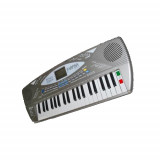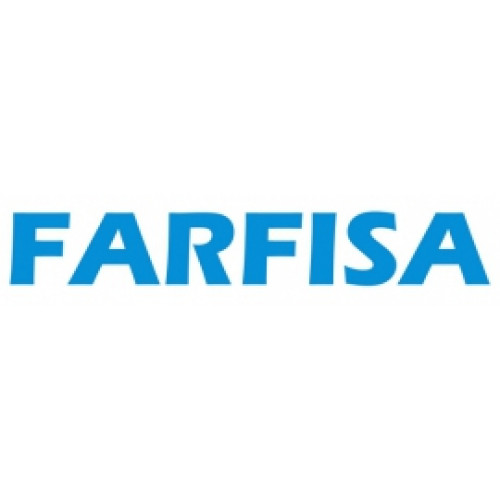The Farfisa brand name is commonly associated with a series of compact electronic organs, and later, a series of multi-timbral synthesizers. At the height of its production, Farfisa operated three factories to produce instruments, in Ancona in the Marche region of Italy. Farfisa also made radios, televisions, and other electronic items. Today the Farfisa brand mainly produces intercom systems with the company Aci Farfisa which makes and distributes systems for video intercoms, access control, video surveillance and home automation. The Bontempi group owns the keyboard division Farfisa brand name. The Farfisa brand name is an acronym for "FAbbriche Riunite di FISArmoniche", which translates to "united factories of accordions". Farfisa first started manufacturing electric organs in 1964. Distribution in the U.S. was handled by the Chicago Musical Instrument Co, which also owned Gibson, and the instruments were originally known as CMI organs when first introduced there. Unlike other combo organs, such as the Vox Continental, Farfisa organs have integrated legs, which can be folded up and stored inside its base. The first models to be produced were the Compact series of organs between 1964 and 1968. The range of FAST (Farfisa All-Silicon Transistorized) organs was launched at the 1968 NAMM show, and production of the Professional series appeared around the same time. Production of combo organs ended in the late 1970s after synthesizers had become more commonplace.
The earliest known use of a Farfisa in popular music was in the Del Shannon 1962 song "Ginny in the Mirror". However, one of the first rock organists to play and spotlight the Farfisa was Domingo Zamudio, better known as "Sam the Sham", who with his group The Pharaohs had their first hit "Wooly Bully" in the summer of 1965. In 1966, a Farfisa was prominently heard in "Double Shot (Of My Baby's Love)" as recorded by the South Carolina-based group The Swingin' Medallions. Spooner Oldham, the house organist of Alabama recording studio Muscle Shoals Sound Studio, can be heard playing the Farfisa on numerous southern soul recordings from the 1960s, notably "When a Man Loves a Woman" by Percy Sledge and "I Never Loved a Man (The Way I Love You)" by Aretha Franklin, among many others. The 1967 release of "Second Best" by The Household Sponge features a Farfisa Compact, played by Geoff Wright.
Richard Wright's use of the Farfisa Compact Duo was integral to the sound of Pink Floyd's early albums, such as The Piper at the Gates of Dawn and Ummagumma. By 1970, he had started to use a Hammond Organ onstage and alternated between that and the Farfisa, depending on the song.[5] The Farfisa was last used on "Time" from The Dark Side of the Moon, but Wright reintroduced it to his keyboard setup on David Gilmour's 2006 tour, featured notably on the Pink Floyd song "Echoes". Sly Stone from Sly and the Family Stone played a Farfisa Professional, as documented at their 1969 Woodstock Festival performance.
Hugh Banton from Van der Graaf Generator originally used Farfisa organs, most notably the Professional, applying his knowledge of electronics and contacts as a former BBC engineer to customise it with a variety of additional effects pedals, including distortion and phasing. The Professional is the only organ used on The Aerosol Grey Machine and The Least We Can Do Is Wave to Each Other, after which he also started using Hammonds. It was retired after the group's 1972 split. John Paul Jones of Led Zeppelin used a Farfisa on "Dancing Days" from Houses of the Holy, as well as occasionally using a VIP-255 or a Professional model on stage. Another famous recording is the 1970 A Tribute to Jack Johnson by Miles Davis, where Herbie Hancock plays spontaneous licks on a broken Farfisa.
With the advent of synthesizers, organs such as the classic Farfisa seemed to be headed for obsolescence, but time proved otherwise. In the late 1970s, with older models becoming cheaper, numerous punk rock and New Wave bands (especially those influenced by 1960s garage rock and psychedelia), such as Blondie, The B-52s, Suicide, Squeeze, Human Switchboard and Talking Heads embraced Farfisas as substitutes for more sophisticated keyboards and synthesizers. Their classic sound, in turn, became a staple on multitimbral instruments, first synthesized, then sampled from the originals. The Farfisa has also been used by rock bands, including Green Day in the song "Misery".
"Crocodile Rock" by Elton John features a Farfisa organ, played by John in a honky-tonk rhythm with carnival-style riffs. The introduction of the Farfisa into West Africa, during the 1960s and 1970s, played an important role in evolution of Highlife, Mbalax, and later Afro-rock. This can be heard in the work of seminal acts like K. Frimpong and Monomono. The Farfisa sound is today used to impart a stereotypical 1960s-retro essence to music. It was a key ingredient to the sound of bands such as Inspiral Carpets and has appeared recently on many albums by contemporary artists. The Farfisa brand name, meanwhile, continues to appear on contemporary MIDI keyboards. A Farfisa compact was used on The Moons song "Double Vision Love", in a small section of the song. The Moons also used Paul Weller's Farfisa on the song "It's Takin' Over". The Italian keyboardist/artist Joey Mauro used various Farfisas (Syntorchestra, Professional, Compact, Deluxe, and VIP) to create sound in his disco songs.

 ARTURIA Instruments
ARTURIA Instruments
 Drums for Therapy
Drums for Therapy  Harps
Harps
 Lyres
Lyres
 Didgeridoo
Didgeridoo
 Sound Processing
Sound Processing
 Mixing Consoles
Mixing Consoles
 Vinyl Players
Vinyl Players
 Phono Correctors
Phono Correctors
 Karaoke
Karaoke
 Stands and Holders
Stands and Holders
 Trolleys
Trolleys
 Computers, Electronics
Computers, Electronics

